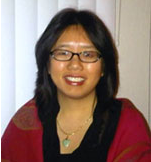Lily Chu
Lily Chu, MD, MSHS, is board certified in both internal medicine and geriatric medicine.[1] In 2006, she developed myalgic encephalomyelitis/chronic fatigue syndrome (ME/CFS).[2]
Education[edit | edit source]
As per LinkedIn bio:[3]
- Geriatric Medicine Fellowship, University of California, Los Angeles
- MSHS, Public Health, University of California, Los Angeles
- Internal Medicine Residency, University of Rochester
- MD, University of Washington
- BS, Biology, University of Washington
Boards and Committees[edit | edit source]
- Community Advisory Board Member at Stanford University Myalgic Encephalomyelitis/ Chronic Fatigue Syndrome Initiative[4]
- Co-Vice president of the International Association for Chronic Fatigue Syndrome/Myalgic Encephalomyelitis[5]
- Panel member of the 2015 Institute of Medicine report: Beyond Myalgic Encephalomyelitis/Chronic Fatigue Syndrome: Redefining an Illness[6]
April 2013 FDA Workshop Survey[edit | edit source]
Open Letter to The Lancet[edit | edit source]
Two open letters to the editor of The Lancet urged the editor to commission a fully independent review of the PACE trial, which the journal had published in 2011. In 2016, Dr. Chu, along with 41 colleagues in the ME/CFS field, signed the second letter.
- 10 February 2016, An open letter to The Lancet, again - Virology blog
Quotes[edit | edit source]
- 2016 - "Ultimately the best way to prevent suicide in ME/CFS will be to find effective disease-modifying treatments or cures for it."[7]
Publications[edit | edit source]
- May 2016, Suicide and ME/CFS -- Lily Chu, MD, MSHS
- 2012, "Exercise and chronic fatigue syndrome: maximize function, minimize post-exertional malaise," Letter to the Editor, European Journal of Clinical Investigation[8]
Notable Studies[edit | edit source]
- 2017, Patients diagnosed with Myalgic encephalomyelitis/chronic fatigue syndrome also fit systemic exertion intolerance disease criteria
Abstract - Background: Myalgic encephalomyelitis/ chronic fatigue syndrome (ME/CFS) remains undiagnosed in up to 91% of patients. Recently, the United States-based Institute of Medicine (IOM) developed new diagnostic criteria, naming it systemic exertion intolerance disease (SEID). Purpose: We examined how subjects fit SEID criteria and existing ME/CFS case definitions early in their illness. Methods: A total of 131 subjects fitting 1994 Fukuda CFS criteria at the time of study recruitment completed a survey of symptoms they experienced during their first 6 months of illness. Symptoms were drawn from SEID and existing criteria (1994 Fukuda, 2003 Canadian Consensus Criteria (CCC), and 2011 Myalgic Encephalomyelitis-International Consensus Criteria (ME-ICC)). We calculated and compared the number/percentage of subjects fitting single or combinations of case definitions and the number/percentage of subjects with SEID experiencing orthostatic intolerance (OI) and/or cognitive impairment. Results: At 6 months of illness, SEID criteria identified 72% of all subjects, similar to when Fukuda criteria (79%) or the CCC (71%) were used, whereas the ME-ICC selected for a significantly lower percentage (61%, p < .001). When severity/frequency thresholds were added to the Fukuda criteria, CCC and ME-ICC, the percentage of these subjects also fitting SEID criteria increased to 93%, 97%, and 95%. Eighty-seven percent of SEID subjects endorsed cognitive impairment and 92%, OI; 79% experienced both symptoms. Conclusions: SEID criteria categorize a similar percentage of subjects as Fukuda criteria early in the course of ME/CFS and contain the majority of subjects identified using other criteria while requiring fewer symptoms. The advantage of SEID may be in its ease of use.[9]
Talks and Interviews[edit | edit source]
Questions to NIH during Advocacy Call[edit | edit source]
- 2 Nov 2016, NIH ME/CFS Advocacy Call with Dr. Walter Koroshetz, Dr. Vicky Whittemore, Dr. Joseph Breen, and Dr. Avindra Nath - (Recorded call and Transcript) - During the question and answer session, Dr Chu asked if the ME/CFS interest group seminars would be online and open to extramural investigators but was told by Dr. Avindra Nath that the seminars were set up to be one-on-one interactions.
HHS/CFSAC Testimony[edit | edit source]
- CFSAC Public Testimony December 2014
- Written Testimony for June 2012 meeting
- Written Testimony for Nov 2011 meeting
- Written Testimony for May 2011 meeting
- Written Testimony for October 2009 meeting
Online Presence[edit | edit source]
References[edit | edit source]
- ↑ http://iacfsme.org/Organization/Leadership-of-the-IACFS-ME/Lily-Chu.aspx
- ↑ https://www.smore.com/wk2p-health-professions-speaker-series
- ↑ https://www.linkedin.com/in/lilychu1
- ↑ https://med.stanford.edu/chronicfatiguesyndrome/about/team.html
- ↑ http://iacfsme.org/Organization/Leadership-of-the-IACFS-ME.aspx
- ↑ http://me-pedia.org/wiki/Institute_of_Medicine_report
- ↑ http://http://iacfsme.org/PDFS/2016MayNesletter/Attachment-03-Dr-Lily-Chu-ME-CFS-and-suicide.aspx
- ↑ Chu, L.; Friedberg, F.; Friedman, K.J.; Littrell, N.; Stevens, S.; Vallings (2012), "Exercise and chronic fatigue syndrome: maximize function, minimize post-exertional malaise", European Journal of Clinical Investigation, 42: 1362, doi:10.1111/j.1365-2362.2012.02723.x
- ↑ Chu, Lily; Norris, Jane; Valencia, Ian J.; Montoya, Jose G. (2017), "Patients diagnosed with Myalgic encephalomyelitis/chronic fatigue syndrome also fit systemic exertion intolerance disease criteria", Fatigue: Biomedicine, Health & Behavior, 5, doi:10.1080/21641846.2017.1299079


